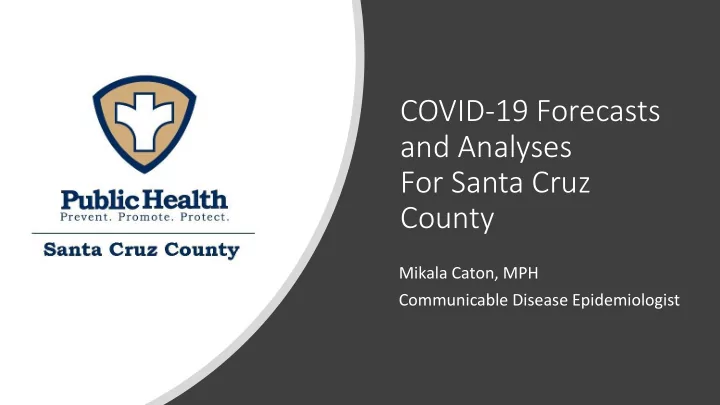

COVID-19 Forecasts and Analyses For Santa Cruz County Mikala Caton, MPH Communicable Disease Epidemiologist
• Communicable Disease Response • General Disease Modeling Objectives • Modeling the Epidemic in Santa Cruz County • Additional Analyses
Communicable Disease Response COVID-19 Forecast General Public Health Nurse Modeling and Data Case Investigations Surveillance Analyses • Care and Follow-up for • County Hospitalized • Collaborate with the Known Cases Cases Projections State, Public and Private • Contact Tracing • Estimate County Labs, and Medical • Exposure Risk Providers to Provide: Doubling-Time • Data on Known Cases • Comparing Confirmed Notifications and Education • Sources of Exposure Cases in California by • Outreach to Congregate County • Age/Gender/Race Living and High-Risk Demographics Populations
Disease models… • Make projections during an outbreak • Are based on parameters that reflect our knowledge about the disease and the population • Show how the disease moves through a population
Disease models rely on parameters. Parameters… • Determine how the disease moves through the model population • Initially come from research and can be updated by the model using local data • Heavily influence the model’s projections
• The model is built on: • Parameters • Equations • Local Data (laboratory confirmed cases, hospitalizations, and deaths) How does it • Runs 4,000 simulations using a statistical work? analysis program, Stan • It then fine-tunes the parameters inputted using the local data • Projects a range of different scenarios that fit the inputs provided
Santa Cruz County COVID-19 Hospitalization Projections (non-cumulative) Date model was run: 05/05/2020
Santa Cruz County Model Considerations Strengths • Provides a median estimate and • Limited by our knowledge of the uncertainty around that estimate disease. using credible intervals • Could drastically change if we • Provides a range of plausible were to get a cluster in a outcomes based on current congregate setting knowledge of COVID-19 • It cannot account for major, future • Fits to local data changes in planned policy • Helps us plan for hospital surge interventions or human behavior. • Projects based on current • Does not predict the future understanding of policy interventions and human behavior
General Limitations of Disease Modeling • Since every model is based on a set of assumptions and parameters, it is helpful to review other models to compare projections, trends, and methods. Each model will likely show different results. • Models have wide levels of uncertainty and projections will change as new research and data about COVID-19 become available. • Models do not “predict” the future and should be used with other resources for planning purposes.
• Disease modeling can help us estimate the date and magnitude of a “surge”. Informing • However, it cannot give us all the answers. Planning • Given the limitations, additional data analyses Efforts and metrics are also used to inform planning efforts.
The time it takes for the cumulative case count to double Doubling- Indication of spread in our Time Analysis community A higher doubling-time the better!
Santa Cruz County Average Doubling-Time
Comparing to California Counties
Modeling for Recovery • Disease modeling is a guide for modifying Orders, but not the only factor. • The Governor has six indicators for the Roadmap to Reopening. • Order modifications are guided by equity and health risk.
Acknowledgements • Paul Mattern, PhD, UC Santa Cruz • Incident Command Post, Disease Investigation Branch
Questions? For more information, see our website. The model is updated every Wednesday.
Recommend
More recommend